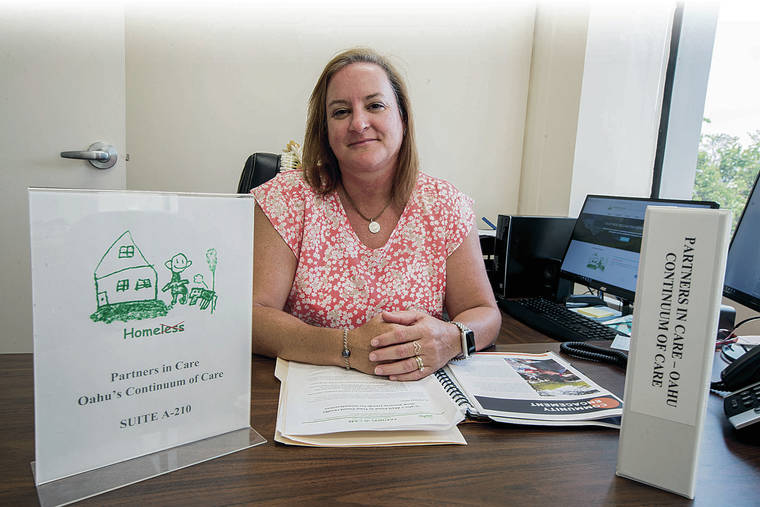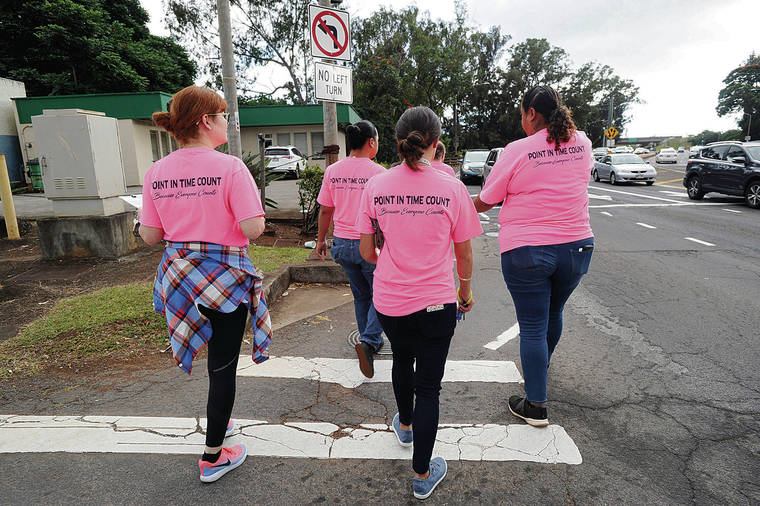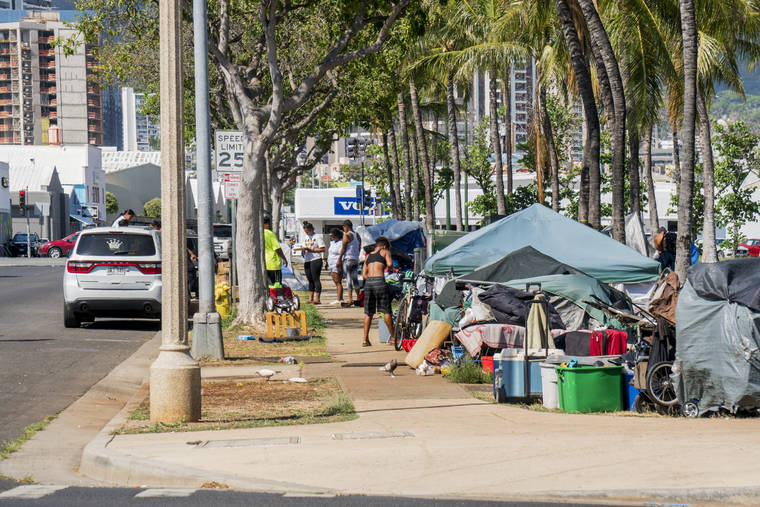New head of Hawaii homeless coalition has a familiar name


DENNIS ODA / DODA@STARADVERTISER.COM
Partners in Care has selected Laura E. Thielen, shown here in her North Vineyard Boulevard office, as its new executive director. She will head the annual homeless census called the Point in Time Count.

BRUCE ASATO / JAN. 22
A group of Point in Time Count volunteers comb the Wahiawa Dog Park for the annual count, which new Partners in Care Executive Director Laura E. Thielen will now head.

DENNIS ODA / DODA@STARADVERTISER.COM
A makeshift encampment of homeless has sprung up along Cooke Street at Kakaako Mauka Gateway Park.




The new head of the organization that conducts Oahu’s annual homeless census has a familiar name but an entirely different background outside of state politics.
Laura E. Thielen, who recently was named executive director of Partners in Care, said she is “constantly” confused with her sister-in-law, state Sen. Laura H. Thielen (D, Hawaii Kai-Waimanalo-Kailua), and with her mother-in-law, state Rep. Cynthia Thielen (R, Kailua-Kaneohe).
“I usually go to meetings with the caveat that I’m not that one, I’m the other one,” Laura E. Thielen said from her new office on North Vineyard Boulevard.
“Cynthia Thielen is my husband’s mother. … Laura H. is my sister-in-law,” Laura E. Thielen said. “Laura kept her maiden name and I took my married name.”
Her new job represents a homecoming for Thielen, who served as chairwoman of Partners in Care a dozen years ago.
Long before her professional career as a social worker, Thielen started out as a 15-year-old feeding women and their children at a Sacramento, Calif., day center.
Don't miss out on what's happening!
Stay in touch with breaking news, as it happens, conveniently in your email inbox. It's FREE!
Before and after she received her master’s degree in social work from the University of Hawaii in 2007, Thielen continued to work to house the homeless, including helping then-Gov. Linda Lingle open Kakaako’s Next Step Shelter in 2005.
From 1998 to 2005 — and again from 2007 to 2009 — Thielen estimates that she helped “a couple hundred” homeless people on Oahu get into what’s now called Housing First rental units through the Health Care for the Homeless Project.
“Housing First works,” Thielen said.
The nationwide program takes the most chronically homeless — some of whom might have mental health or substance abuse issues — and places them into market-rate rental units. Landlords are assured of rental payments and have access to case managers and social workers to deal with any problems.
“They’re not just putting somebody into that house today and never seeing them again,” Thielen said.
Connie Mitchell, chairwoman of Partners in Care’s board of directors, said in an email about Thielen:
“We are blessed and excited to have someone with such diverse direct experience working with homeless persons coupled with policy experience leading this new era of Partners in Care. She’s got the heart and the head for this work. Her passion and management experience will help launch a new chapter of PIC as a private nonprofit organization with a vision for building and equipping an efficient and effective system for ending homelessness.”
During this year’s Point in Time Count, which was conducted over four days in January, a record number of more than 700 volunteers fanned out across Oahu to ask homeless people 22 questions.
The outpouring of volunteers showed Thielen that people on Oahu want to understand the problem and help find solutions.
“I think there is a lot of ownership around this,” Thielen said. “More and more people are realizing how big of a problem it is. Twenty-some years ago it was very much ‘not in my backyard.’ That’s still there, but I think it’s decreased and people are understanding there are different types of homeless.”
Thielen is already thinking of January 2020’s Point in Time Count but has lots of ideas in the meantime.
>> She hopes to speak to community groups and help guide them through what the Point in Time Count found for their neighborhoods across Oahu.
“Anyone who wants some information, I’ll share everything,” Thielen said. “If the public encounters someone out on the streets or in their neighborhood, fear is probably the first thing they have: fear for themselves, their families, their property. That’s understandable. But I also think there’s a lot of compassion. The frustration is knowing what to do. Folks in the community want something tangible they can do to help.”
>> Partners in Care’s data manager, Jay Purvis, is digging through the latest Point in Time Count results to help social service agencies identify key information and help find solutions.
For instance, the Point in Time Count found that Waikiki’s homeless population “is disproportionately white” while the homeless population along the Waianae Coast “is disproportionately Native Hawaiian or multiracial.”
Partners in Care can help connect agencies to funding and partnerships, such as organizations that are already working with Native Hawaiians and Pacific Islanders, Thielen said.
>> And she wants to help smaller organizations upload their own homeless information — as well as connect to real-time data on existing programs — so they can be part of the larger effort on Oahu called the coordinated entry system.
“There’s nothing more frustrating than an outreach worker trying to get someone into a program,” Thielen said. “If we can coordinate and make sure they go to the right place, it’s going to be a faster turnaround.”
>> Thielen also wants to work on making Oahu’s homeless shelters a better alternative to living on the street, especially given this year’s 12% increase in “unsheltered” homeless people.
“We need to make them more hospitable,” Thielen said of the shelters. “For people with severe mental illness, staying in a room with 20 other people may not be the best for them.”
>> After people get stabilized in a shelter, where they are surrounded by social workers and case managers, the next challenge is finding them a permanent place to live in an otherwise red-hot housing market, Thielen said.
“Public housing was the next steppingstone,” she said. “It no longer is. We need to figure out the next steppingstone.”
Meet the new executive director of Partners in Care, which conducts Oahu’s annual homeless census.
(Video by Dan Nakaso / dnakaso@staradvertiser.com)



